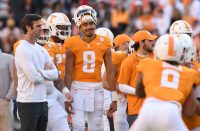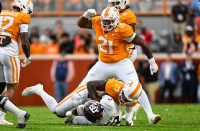Earlier this week Jimmy Hyams quoted some of Tennessee’s offensive linemen saying they wanted John Kelly to get 2,000 yards this season. Perhaps they’re unaware that no one at Tennessee has ever run for even 1,500 yards in a single season, but hey, aim high!
It’s not fair to Kelly to call his sophomore season a good news/bad news campaign. He is Exhibit A in the, “Just because they were playing behind someone great doesn’t mean they can’t be great,” argument for Team 121. It was no sin to be third team behind Jalen Hurd and Alvin Kamara in their final seasons in Knoxville. The “bad news” side of the equation is, when he did get his chances, most of Kelly’s productivity came against lesser competition: only six carries in the first five games plus Alabama, none against Florida or Georgia. Most of his 630 yards last year came against Texas A&M, Nebraska, and the late October-November stretch that didn’t feature a Top 50 defense.
The good news is those 630 yards came on only 98 carries. That’s 6.43 yards per carry. And when you break out the media guide and compare that to what the leading running back has done at Tennessee since 1980, it’s very good news indeed:
| Year | Back | Att | Yds | YPC |
| 1993 | Charlie Garner | 159 | 1161 | 7.30 |
| 2006 | LaMarcus Coker | 108 | 696 | 6.44 |
| 2016 | John Kelly | 98 | 630 | 6.43 |
| 1994 | James Stewart | 170 | 1028 | 6.05 |
| 1992 | Charlie Garner | 154 | 928 | 6.03 |
| 1989 | Chuck Webb | 209 | 1236 | 5.91 |
| 1997 | Jamal Lewis | 232 | 1364 | 5.88 |
| 1983 | Johnnie Jones | 191 | 1116 | 5.84 |
| 1990 | Tony Thompson | 219 | 1261 | 5.76 |
| 2004 | Gerald Riggs | 193 | 1107 | 5.74 |
First of all, let’s all tip our cap to Charlie Garner’s 1993 campaign. You can make an argument that the ’93 Vols were Tennessee’s most dangerous team of the decade; put a future Pro Bowler like Garner in the backfield with the Heisman runner-up at quarterback, and you get fireworks.
LaMarcus Coker is an interesting comparison for John Kelly. Coker’s 2006 season came as part of a crowded backfield with Arian Foster and Montario Hardesty, and much of his success came against lesser opponents: 417 of his 696 yards came against Marshall, Memphis, and Vanderbilt; 176 of those yards on two runs. He was dismissed from the team the following season while still competing with Foster and Hardesty. But John Kelly has the lead back role all to himself this fall.
Having historically great numbers against below average competition is no guarantee. It’s what makes Kelly both so intriguing and so difficult to project this fall. As he and the line are chasing numbers, Tennessee’s single season rushing record can be had if he averages 113 yards per game. As the lead back in what should continue to be an up-tempo offense, that’s not out of the question. It’s strange to think about something like that just a year after being so sure we were going to see the career record fall to Jalen Hurd. School records aren’t a fair expectation, but it might not be an exaggeration.
What can we expect from John Kelly this fall? He’ll run hard and his linemen talk like they’ll genuinely enjoy blocking for him. That’s always a good sign. Maybe he’ll settle at solid and some of the Vols’ talented freshmen will get to make some hay as well. But there is at least the potential for something special in Tennessee’s backfield from #4.




The Vols were great in the 90s & early 00’s when we ran NFL backs behind an NFL line and balanced that with long balls to Wide Receiver U NFL Receivers. Thanks to Jones, we now have the talent restored to the level at which we should expect great results on the field. The question for me is: will our scheme (and in-game coaching/play calling) allow for a dominant running attack and a balanced passing game? If so, this could be a special year. If we stay focused on going fast at the expense of executing every play well, then… Read more »
“Going fast at the expense of executing every play well” – this will be interesting to watch with a new QB. We ran significantly fewer plays last year (896) than in 2015 (988) or 2014 (977). I think this is mostly because we hit more big plays last year, but I’m curious to see how it plays out this fall.
Interesting. For whatever reason, I hadn’t really thought much about the pace thing being anything more than just trying to get an advantage over the defense on any given play. But the sheer volume of attempts should also have some bearing as well, and I’d hate to give that up.
I am encouraged by the changes as well. I think we’ll actually be better overall. The only question I have is how much the other teams may have changed as well.
I’m curious about whether Scott changes up the mix of formations on offense as part of this calculus. Operating under the assumption that Dormady wins the starting job, how does a spread-based rushing attack work when you don’t have a running threat at QB? We have some idea of this from 2013 (4.92 YPC) and 2014 (3.63 YPC) with Worley at the helm, but those teams had great and not-so-great offensive lines, respectively (plus some Dobbs in both years). I don’t know if I-formation works anymore, but I guess I’m old enough that I’m hesitant to believe you can be… Read more »
Also of note: would they go under center with two tight ends, and if so, is there a non-liability #2 tight end on the roster?
They do keep saying that Dormady is mobile enough, but yeah, one eyebrow raised until I see it.
My understanding is Dormady had more rushing yardage in high school. I haven’t checked that stat to see if it is a season-by-season comparison or a total in high school (where variable starting opportunities/injuries could throw it off).
I guess the question really is can Dormady running be a FEATURE of the offense or will it be a once or twice a game gimmick?
Because playing with an 80% NFL line in 2013, Worley had 19 carries for 56 yards. I’m just not sure that Dormady having two 5-yard rushes every game really keeps the end from crashing.